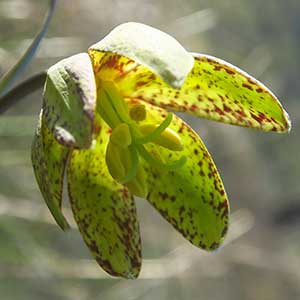Fritillaria glauca
Fritillaria agrestis
Siskiyou fritillaria, Siskiyou fritillary, Siskiyou missionbells
stink bells
large 3–9; small 1–9.
large 2–9; small 0–2.
0.8–2 dm.
3–6 dm.
2–4, alternate, 3.5–9 cm;
blade lanceolate-oblong, sickle-shaped, glaucous.
5–12, alternate, crowded near proximal center of stem, 5–15 cm;
blade linear to lanceolate-oblong.
nodding;
tepals purplish or greenish marked with yellow, lanceolate-oblong, 1.5–2.5 cm, apex not recurved;
nectaries green with maroon dots, broadly lanceolate, less than 1/2 tepal length;
style obviously branched for 1/2 its length, branches longer than 1.5 mm.
nodding, odor definitely unpleasant;
tepals greenish to purplish brown adaxially, white or yellow abaxially, ovate, 1.8–3.5 cm, apex not recurved;
nectaries prominent, green, narrowly linear, forming narrow band 2/3 to equaling tepal length;
style obviously branched for 1/2 its length, branches longer than 1.5 mm.
broadly winged.
angled.
= 24.
= 24.
Fritillaria glauca
Fritillaria agrestis
This species is uncommon.
(Discussion copyrighted by Flora of North America; reprinted with permission.)


